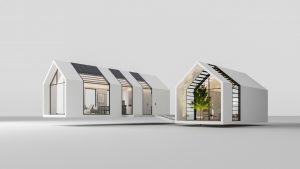The building construction industry is traditionally one of the most resource-intensive sectors in the world: 36% of all CO2 emissions are related to the construction industry. In addition to the substantial raw materials consumed daily for buildings, roads, and other construction, such projects often require elevated energy consumption—not just in direct consumption of fossil fuels but through the production of millions of pounds of steel and cement.
Further, construction and demolition activities generate a considerable amount of waste. This waste can come from unused materials, debris from demolition, and materials discarded during the construction process due to damage or errors. The management of such waste is a challenge and contributes to the resource-intensive nature of industry.

To quantify the situation, we want to highlight that buildings are responsible for around 50% of the consumption of all extracted raw materials, 33% of water consumption, and 30% of global waste. Environmental sustainability is no longer merely a matter of image for the industry—it is an urgent need for the survival of our planet and the well-being of future generations, and is demanded by consumers. The imperative for eco-friendly practices is driving the shift toward sustainable design, construction, and building operations.
This article explores how digitalization tools, particularly Building Information Modeling (BIM) software, are driving better practices and supporting overall waste management and sustainability goals.
1. Sustainable Planning – Early Evaluation And Design
The planning phase of any construction project lays the foundation for its environmental impact. The architect needs to consider factors such as waste reduction, efficient use of materials, carbon-neutral energy generation, and costs, among others. Digital methods, specifically BIM, are instrumental in addressing these aspects. Through such methods, users can more easily evaluate the sustainability level of a design and the resultant embodied carbon, enhance the environmental footprint of a property portfolio, minimize planning errors, and streamline construction processes, thereby aiding the industry in achieving its sustainability targets.

The introduction of BIM software into architectural design has made it possible to plan with a high level of precision, helping minimize waste by reducing the need for later alterations or demolition and allowing for more efficient use of resources.
Additionally, BIM enables easy evaluation of building components with respective materials and their CO2 emissions. Architects and engineers can consider alternative systems before finalizing plans, as well as potentially calculate the ecological impact of every building component throughout its lifecycle. They can then identify and implement critical enhancements early on.
The introduction of BIM software into architectural design has made it possible to plan with a high level of precision, helping minimize waste by reducing the need for later alterations or demolition and allowing for more efficient use of resources. Bringing contractors on board during this planning process further enhances the potential impact.
2. Sustainable Building – Eliminating Waste During Construction
The construction site is constantly evolving. Digitalization tools, including BIM, are becoming more and more critical to daily operations and are offering benefits that were either too time-intensive or expensive in the past. By offering all project participants secure access to centrally curated data in real time, these tools can reduce the likelihood of errors and contribute to more efficient project management. This is most evident in the areas of prefabrication and modular construction. With parametric BIM solutions, a high degree of detailed planning automation is achievable, facilitating the rapid creation of various construction plans. The impact of these evaluations is maximized when construction expertise is engaged during early planning. Construction teams can streamline projects, leading to a natural reduction of material usage, a key factor in improving the industry’s sustainability credentials.

Once production begins, BIM facilitates swift and transparent communication between fabricators, construction site teams, and offices, bridging gaps that have historically hindered progress. Regularly comparing BIM models with point clouds offers a timely method for identifying quality defects, helping to avoid potential issues that might arise in subsequent stages of the project.
All of this can have secondary benefits as well. By digitally monitoring and controlling more of the construction process, engineers and site managers can more effectively calculate a project’s overall carbon footprint—something that is increasingly crucial in today’s environmentally conscious landscape. In addition to enabling better compliance with regulations, this allows for proactive adjustments to construction practices, improving the project’s overall environmental impact.
The adoption of BIM and other digitalization tools offers immense potential to revolutionize the construction sector. Not only does it promote efficiency and accuracy in the construction phase—it significantly contributes to sustainability efforts, a pivotal element in building a more environmentally responsible future.
3. Sustainable Building Management – Reducing Lifetime Costs
Currently, approximately 80% of a building’s lifetime costs are tied to the operational phase, primarily due to energy consumption. However, digitalization tools are changing the landscape, improving building management, optimizing the control of heating, ventilation, and lighting systems, reducing energy use, and cutting costs, among other factors.
Where BIM models are useful in the design and construction–to analyze materials and construction methods–digital twin technologies can help facilitate more efficient, sustainable, and user-friendly buildings that adapt to changing needs and environments. Whether derived from the original design and construction process or reconstructed from a point cloud and existing 2D plans, digital twins can be integrated with sensor data from building services and artificial intelligence to enable optimal maintenance planning, real-time energy use monitoring, the validation of energy conservation methods, and space-use optimization in buildings.
Additionally, these tools can offer real-time structural condition monitoring, with an increasing number of buildings documented as using these models. Linking a digital twin with a building resource passport elevates its value at the end of a building’s lifecycle. This resource passport, underpinned by the digital twin, offers a detailed record of all used materials, including their types, locations, quantities, and qualities.
Finally, these tools can help at the end of a building’s life–post demolition. With both historical data and a real-time picture of almost every building angle, they offer a well-documented repository of reusable materials for future constructions, enhancing operational efficiency and steering the construction industry toward a more sustainable future.
Eliminating Waste – What Comes Next
Digitalization tools will be instrumental in our pursuit of zero waste and a circular economy in construction. Aided by the meticulous planning, waste reduction, energy efficiency, and operational optimization these tools offer, architects, engineers, construction companies, and building operators will be able to substantially curb the sector’s carbon footprint and its demand on natural resources.
Moreover, as these tools evolve, industry — and society as a whole — will move closer to an era where every building is a well-documented entity, from its initial design through to end of life or adaptive reuse of the structure. Each component, material, and the energy invested in them are tracked and quantified, serving as an invaluable resource for future constructions. Buildings will be more than static entities. They will become dynamic, evolving spaces that seamlessly adapt to the changing needs of their inhabitants and the environment.

The future of the construction industry lies in its ability to leverage these technologies to transform its processes and products. The tools discussed here will allow us to adapt the spaces more easily for people’s needs–reducing the need for demolition and facilitating better design and adaptation. By intertwining the concepts of sustainability, digitalization, and a circular economy, we are not just building structures; we are building a resilient future for our planet and for generations to come.
Source: https://facilityexecutive.com/3-ways-digitalization-can-reduce-construction-waste-in-2024/
